Economic Inequality and Women: A Managerial Economics Report Analysis
VerifiedAdded on 2022/08/16
|17
|4675
|16
Report
AI Summary
This report examines the economic inequality faced by women, focusing on the interconnectedness of gender inequality and economic poverty. It highlights the global perspective, where women are more likely to experience economic insecurity. The report analyzes the impact of women's increased participation in the labor force, including the potential for economic growth and the reduction of income inequality within households. It reviews existing literature and presents a methodology involving quantitative research to collect and analyze data from various companies and organizations. The findings discuss the pay gaps, underrepresentation of women in high-paying positions, and the role of factors such as education, technology, globalization, and government policies in perpetuating economic inequality. The report also covers the importance of addressing the gender pay gap, improving work opportunities, encouraging shared responsibilities, and increasing diversity. The conclusion emphasizes the need for continued efforts to achieve accurate gender pay gap analyses and promote economic equality.
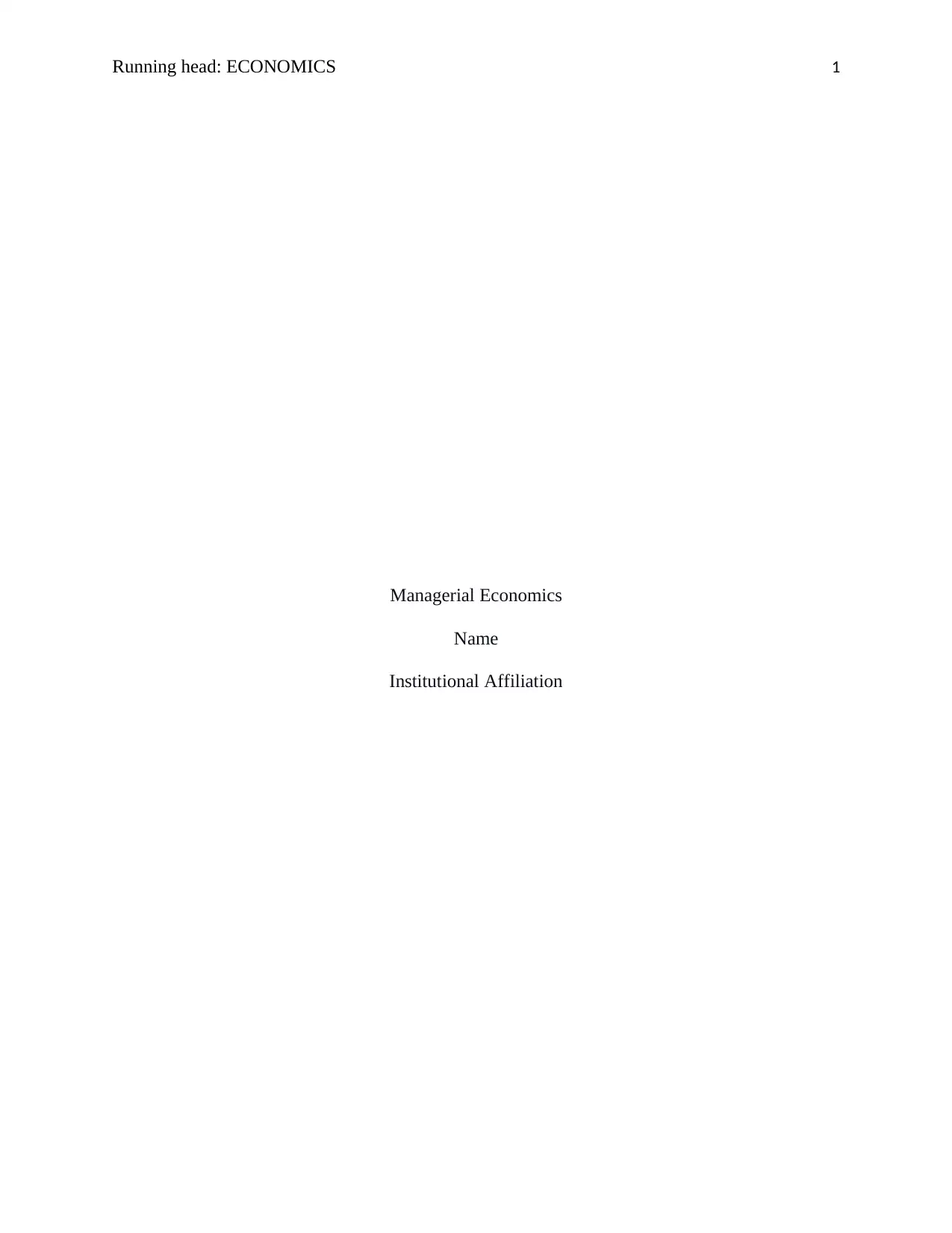
Running head: ECONOMICS 1
Managerial Economics
Name
Institutional Affiliation
Managerial Economics
Name
Institutional Affiliation
Paraphrase This Document
Need a fresh take? Get an instant paraphrase of this document with our AI Paraphraser
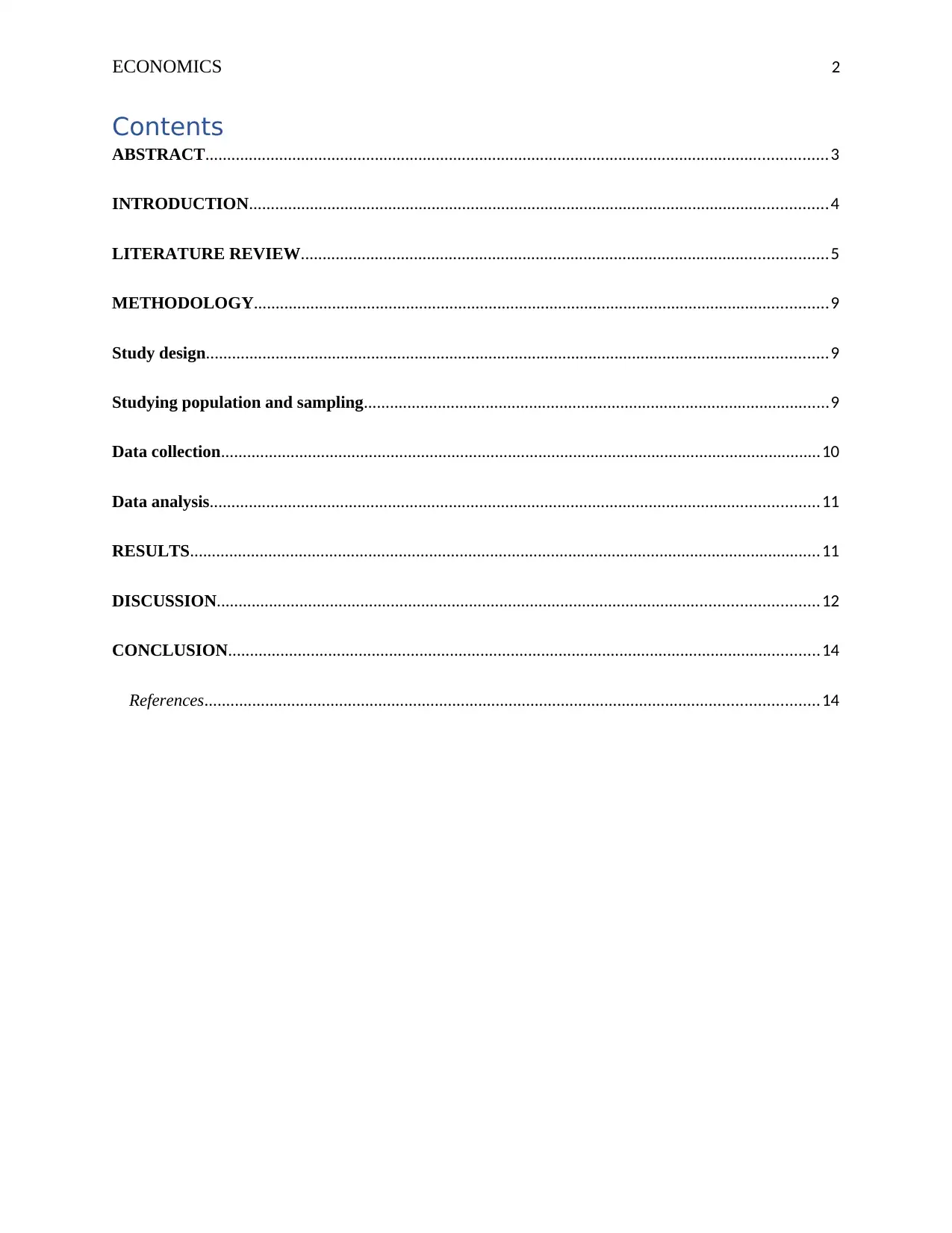
ECONOMICS 2
Contents
ABSTRACT...............................................................................................................................................3
INTRODUCTION.....................................................................................................................................4
LITERATURE REVIEW.........................................................................................................................5
METHODOLOGY....................................................................................................................................9
Study design...............................................................................................................................................9
Studying population and sampling...........................................................................................................9
Data collection..........................................................................................................................................10
Data analysis............................................................................................................................................11
RESULTS.................................................................................................................................................11
DISCUSSION..........................................................................................................................................12
CONCLUSION........................................................................................................................................14
References.............................................................................................................................................14
Contents
ABSTRACT...............................................................................................................................................3
INTRODUCTION.....................................................................................................................................4
LITERATURE REVIEW.........................................................................................................................5
METHODOLOGY....................................................................................................................................9
Study design...............................................................................................................................................9
Studying population and sampling...........................................................................................................9
Data collection..........................................................................................................................................10
Data analysis............................................................................................................................................11
RESULTS.................................................................................................................................................11
DISCUSSION..........................................................................................................................................12
CONCLUSION........................................................................................................................................14
References.............................................................................................................................................14
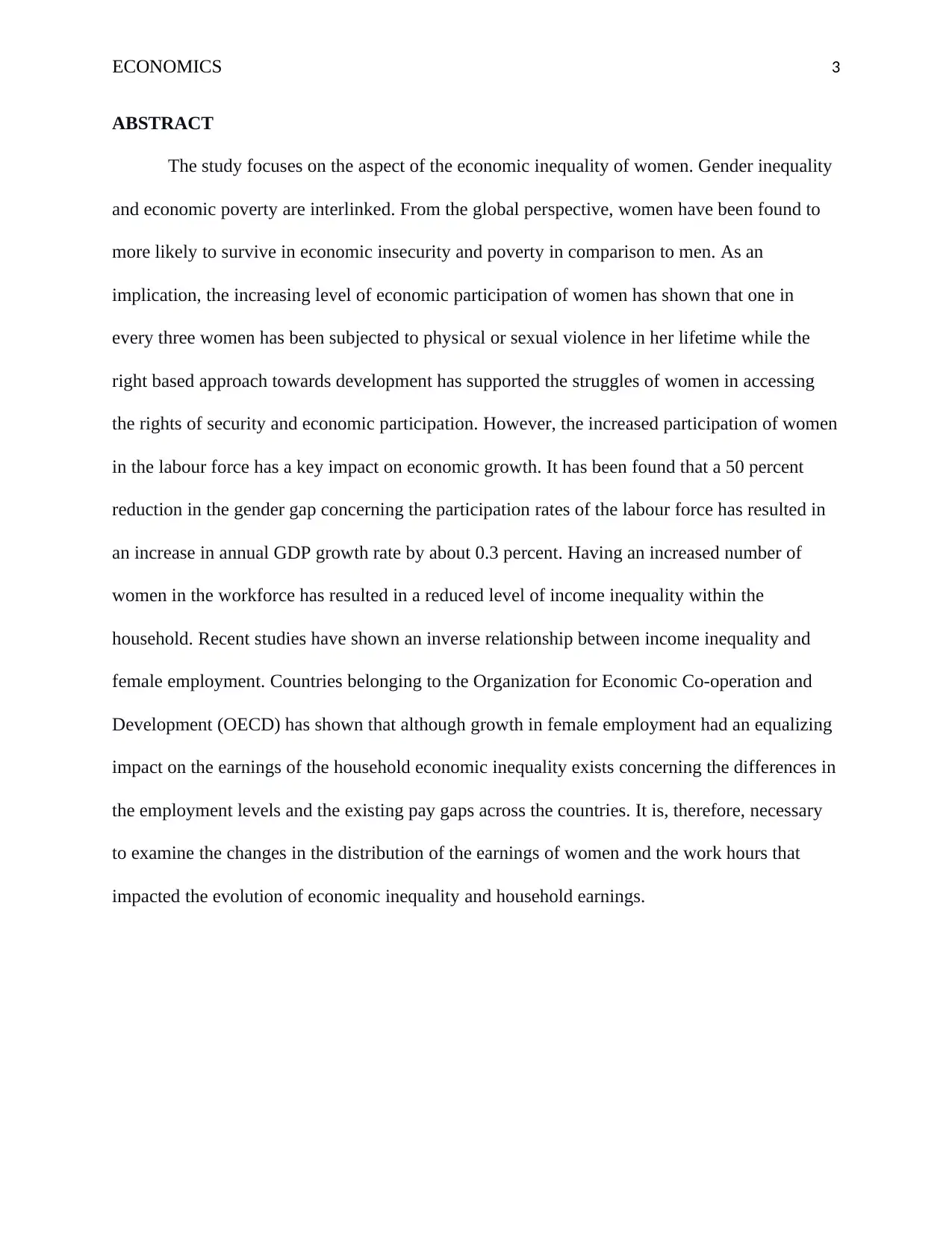
ECONOMICS 3
ABSTRACT
The study focuses on the aspect of the economic inequality of women. Gender inequality
and economic poverty are interlinked. From the global perspective, women have been found to
more likely to survive in economic insecurity and poverty in comparison to men. As an
implication, the increasing level of economic participation of women has shown that one in
every three women has been subjected to physical or sexual violence in her lifetime while the
right based approach towards development has supported the struggles of women in accessing
the rights of security and economic participation. However, the increased participation of women
in the labour force has a key impact on economic growth. It has been found that a 50 percent
reduction in the gender gap concerning the participation rates of the labour force has resulted in
an increase in annual GDP growth rate by about 0.3 percent. Having an increased number of
women in the workforce has resulted in a reduced level of income inequality within the
household. Recent studies have shown an inverse relationship between income inequality and
female employment. Countries belonging to the Organization for Economic Co-operation and
Development (OECD) has shown that although growth in female employment had an equalizing
impact on the earnings of the household economic inequality exists concerning the differences in
the employment levels and the existing pay gaps across the countries. It is, therefore, necessary
to examine the changes in the distribution of the earnings of women and the work hours that
impacted the evolution of economic inequality and household earnings.
ABSTRACT
The study focuses on the aspect of the economic inequality of women. Gender inequality
and economic poverty are interlinked. From the global perspective, women have been found to
more likely to survive in economic insecurity and poverty in comparison to men. As an
implication, the increasing level of economic participation of women has shown that one in
every three women has been subjected to physical or sexual violence in her lifetime while the
right based approach towards development has supported the struggles of women in accessing
the rights of security and economic participation. However, the increased participation of women
in the labour force has a key impact on economic growth. It has been found that a 50 percent
reduction in the gender gap concerning the participation rates of the labour force has resulted in
an increase in annual GDP growth rate by about 0.3 percent. Having an increased number of
women in the workforce has resulted in a reduced level of income inequality within the
household. Recent studies have shown an inverse relationship between income inequality and
female employment. Countries belonging to the Organization for Economic Co-operation and
Development (OECD) has shown that although growth in female employment had an equalizing
impact on the earnings of the household economic inequality exists concerning the differences in
the employment levels and the existing pay gaps across the countries. It is, therefore, necessary
to examine the changes in the distribution of the earnings of women and the work hours that
impacted the evolution of economic inequality and household earnings.
⊘ This is a preview!⊘
Do you want full access?
Subscribe today to unlock all pages.

Trusted by 1+ million students worldwide
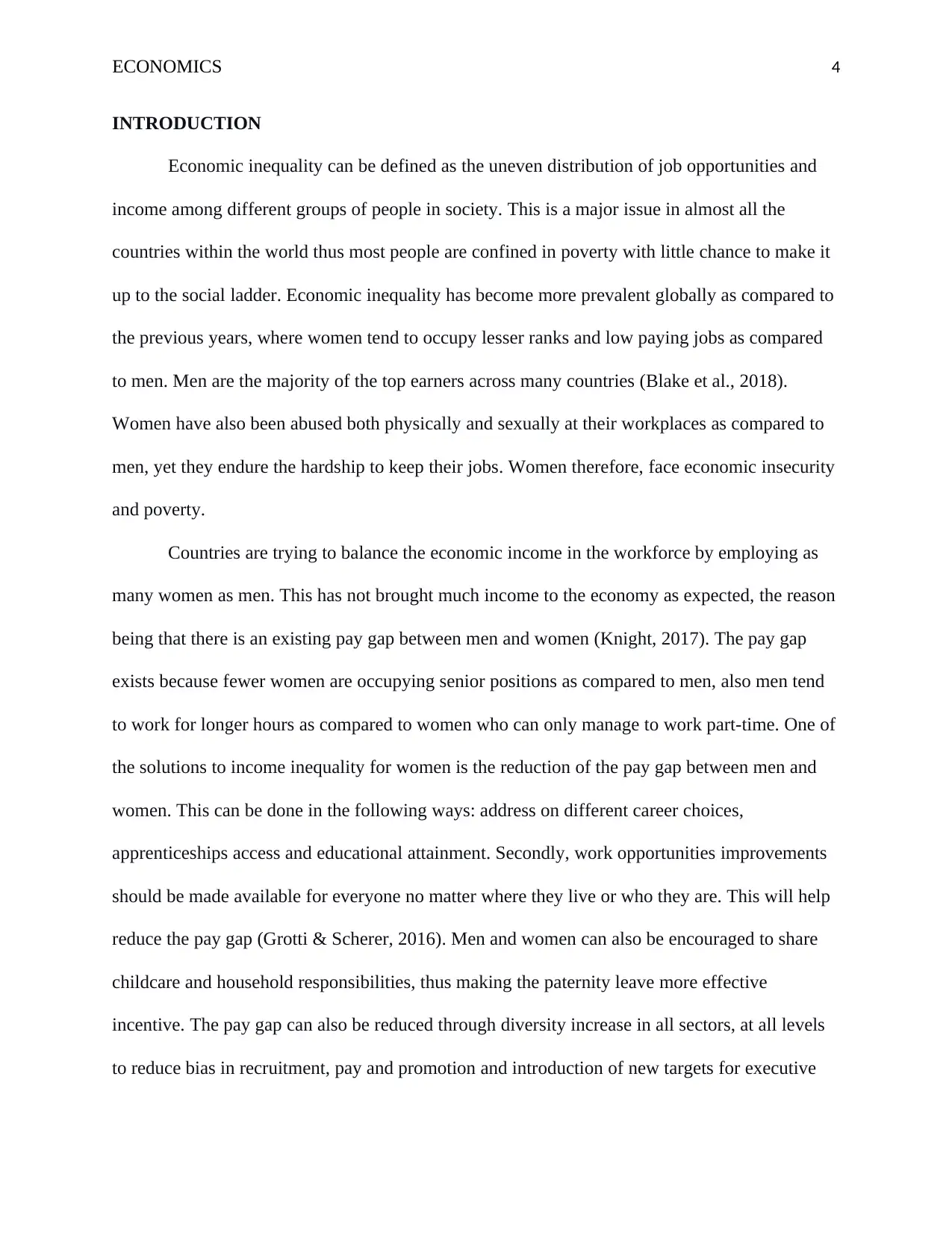
ECONOMICS 4
INTRODUCTION
Economic inequality can be defined as the uneven distribution of job opportunities and
income among different groups of people in society. This is a major issue in almost all the
countries within the world thus most people are confined in poverty with little chance to make it
up to the social ladder. Economic inequality has become more prevalent globally as compared to
the previous years, where women tend to occupy lesser ranks and low paying jobs as compared
to men. Men are the majority of the top earners across many countries (Blake et al., 2018).
Women have also been abused both physically and sexually at their workplaces as compared to
men, yet they endure the hardship to keep their jobs. Women therefore, face economic insecurity
and poverty.
Countries are trying to balance the economic income in the workforce by employing as
many women as men. This has not brought much income to the economy as expected, the reason
being that there is an existing pay gap between men and women (Knight, 2017). The pay gap
exists because fewer women are occupying senior positions as compared to men, also men tend
to work for longer hours as compared to women who can only manage to work part-time. One of
the solutions to income inequality for women is the reduction of the pay gap between men and
women. This can be done in the following ways: address on different career choices,
apprenticeships access and educational attainment. Secondly, work opportunities improvements
should be made available for everyone no matter where they live or who they are. This will help
reduce the pay gap (Grotti & Scherer, 2016). Men and women can also be encouraged to share
childcare and household responsibilities, thus making the paternity leave more effective
incentive. The pay gap can also be reduced through diversity increase in all sectors, at all levels
to reduce bias in recruitment, pay and promotion and introduction of new targets for executive
INTRODUCTION
Economic inequality can be defined as the uneven distribution of job opportunities and
income among different groups of people in society. This is a major issue in almost all the
countries within the world thus most people are confined in poverty with little chance to make it
up to the social ladder. Economic inequality has become more prevalent globally as compared to
the previous years, where women tend to occupy lesser ranks and low paying jobs as compared
to men. Men are the majority of the top earners across many countries (Blake et al., 2018).
Women have also been abused both physically and sexually at their workplaces as compared to
men, yet they endure the hardship to keep their jobs. Women therefore, face economic insecurity
and poverty.
Countries are trying to balance the economic income in the workforce by employing as
many women as men. This has not brought much income to the economy as expected, the reason
being that there is an existing pay gap between men and women (Knight, 2017). The pay gap
exists because fewer women are occupying senior positions as compared to men, also men tend
to work for longer hours as compared to women who can only manage to work part-time. One of
the solutions to income inequality for women is the reduction of the pay gap between men and
women. This can be done in the following ways: address on different career choices,
apprenticeships access and educational attainment. Secondly, work opportunities improvements
should be made available for everyone no matter where they live or who they are. This will help
reduce the pay gap (Grotti & Scherer, 2016). Men and women can also be encouraged to share
childcare and household responsibilities, thus making the paternity leave more effective
incentive. The pay gap can also be reduced through diversity increase in all sectors, at all levels
to reduce bias in recruitment, pay and promotion and introduction of new targets for executive
Paraphrase This Document
Need a fresh take? Get an instant paraphrase of this document with our AI Paraphraser
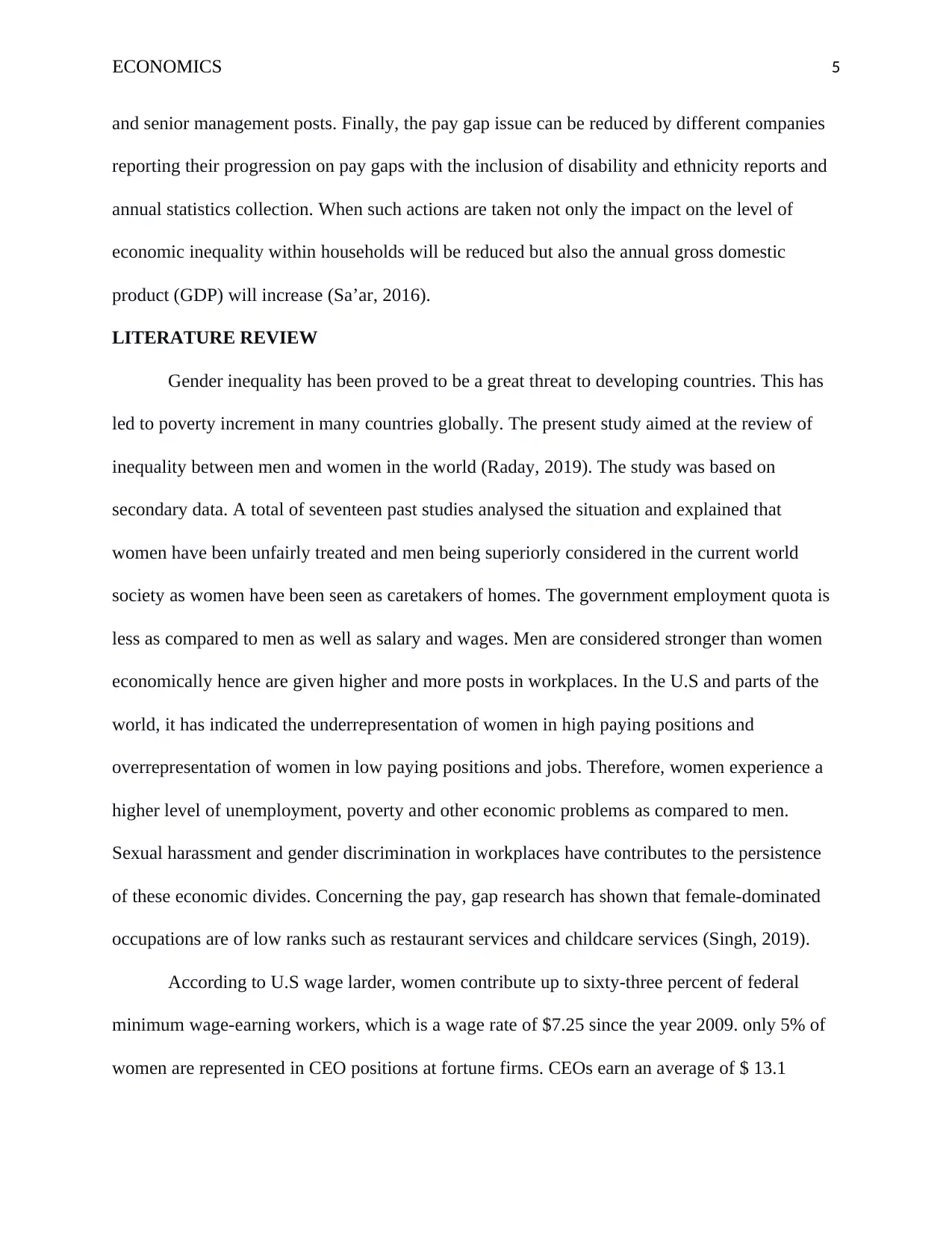
ECONOMICS 5
and senior management posts. Finally, the pay gap issue can be reduced by different companies
reporting their progression on pay gaps with the inclusion of disability and ethnicity reports and
annual statistics collection. When such actions are taken not only the impact on the level of
economic inequality within households will be reduced but also the annual gross domestic
product (GDP) will increase (Sa’ar, 2016).
LITERATURE REVIEW
Gender inequality has been proved to be a great threat to developing countries. This has
led to poverty increment in many countries globally. The present study aimed at the review of
inequality between men and women in the world (Raday, 2019). The study was based on
secondary data. A total of seventeen past studies analysed the situation and explained that
women have been unfairly treated and men being superiorly considered in the current world
society as women have been seen as caretakers of homes. The government employment quota is
less as compared to men as well as salary and wages. Men are considered stronger than women
economically hence are given higher and more posts in workplaces. In the U.S and parts of the
world, it has indicated the underrepresentation of women in high paying positions and
overrepresentation of women in low paying positions and jobs. Therefore, women experience a
higher level of unemployment, poverty and other economic problems as compared to men.
Sexual harassment and gender discrimination in workplaces have contributes to the persistence
of these economic divides. Concerning the pay, gap research has shown that female-dominated
occupations are of low ranks such as restaurant services and childcare services (Singh, 2019).
According to U.S wage larder, women contribute up to sixty-three percent of federal
minimum wage-earning workers, which is a wage rate of $7.25 since the year 2009. only 5% of
women are represented in CEO positions at fortune firms. CEOs earn an average of $ 13.1
and senior management posts. Finally, the pay gap issue can be reduced by different companies
reporting their progression on pay gaps with the inclusion of disability and ethnicity reports and
annual statistics collection. When such actions are taken not only the impact on the level of
economic inequality within households will be reduced but also the annual gross domestic
product (GDP) will increase (Sa’ar, 2016).
LITERATURE REVIEW
Gender inequality has been proved to be a great threat to developing countries. This has
led to poverty increment in many countries globally. The present study aimed at the review of
inequality between men and women in the world (Raday, 2019). The study was based on
secondary data. A total of seventeen past studies analysed the situation and explained that
women have been unfairly treated and men being superiorly considered in the current world
society as women have been seen as caretakers of homes. The government employment quota is
less as compared to men as well as salary and wages. Men are considered stronger than women
economically hence are given higher and more posts in workplaces. In the U.S and parts of the
world, it has indicated the underrepresentation of women in high paying positions and
overrepresentation of women in low paying positions and jobs. Therefore, women experience a
higher level of unemployment, poverty and other economic problems as compared to men.
Sexual harassment and gender discrimination in workplaces have contributes to the persistence
of these economic divides. Concerning the pay, gap research has shown that female-dominated
occupations are of low ranks such as restaurant services and childcare services (Singh, 2019).
According to U.S wage larder, women contribute up to sixty-three percent of federal
minimum wage-earning workers, which is a wage rate of $7.25 since the year 2009. only 5% of
women are represented in CEO positions at fortune firms. CEOs earn an average of $ 13.1
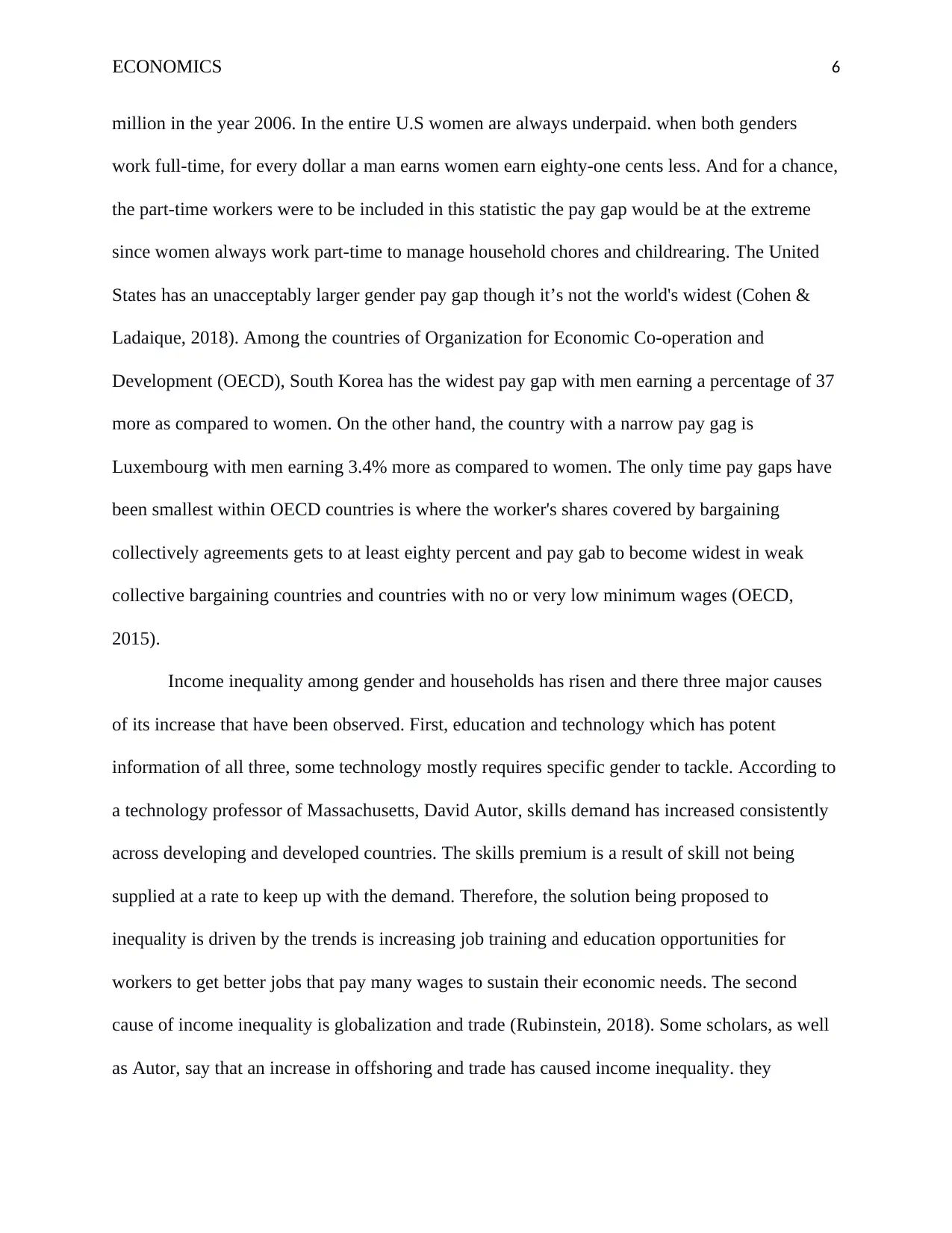
ECONOMICS 6
million in the year 2006. In the entire U.S women are always underpaid. when both genders
work full-time, for every dollar a man earns women earn eighty-one cents less. And for a chance,
the part-time workers were to be included in this statistic the pay gap would be at the extreme
since women always work part-time to manage household chores and childrearing. The United
States has an unacceptably larger gender pay gap though it’s not the world's widest (Cohen &
Ladaique, 2018). Among the countries of Organization for Economic Co-operation and
Development (OECD), South Korea has the widest pay gap with men earning a percentage of 37
more as compared to women. On the other hand, the country with a narrow pay gag is
Luxembourg with men earning 3.4% more as compared to women. The only time pay gaps have
been smallest within OECD countries is where the worker's shares covered by bargaining
collectively agreements gets to at least eighty percent and pay gab to become widest in weak
collective bargaining countries and countries with no or very low minimum wages (OECD,
2015).
Income inequality among gender and households has risen and there three major causes
of its increase that have been observed. First, education and technology which has potent
information of all three, some technology mostly requires specific gender to tackle. According to
a technology professor of Massachusetts, David Autor, skills demand has increased consistently
across developing and developed countries. The skills premium is a result of skill not being
supplied at a rate to keep up with the demand. Therefore, the solution being proposed to
inequality is driven by the trends is increasing job training and education opportunities for
workers to get better jobs that pay many wages to sustain their economic needs. The second
cause of income inequality is globalization and trade (Rubinstein, 2018). Some scholars, as well
as Autor, say that an increase in offshoring and trade has caused income inequality. they
million in the year 2006. In the entire U.S women are always underpaid. when both genders
work full-time, for every dollar a man earns women earn eighty-one cents less. And for a chance,
the part-time workers were to be included in this statistic the pay gap would be at the extreme
since women always work part-time to manage household chores and childrearing. The United
States has an unacceptably larger gender pay gap though it’s not the world's widest (Cohen &
Ladaique, 2018). Among the countries of Organization for Economic Co-operation and
Development (OECD), South Korea has the widest pay gap with men earning a percentage of 37
more as compared to women. On the other hand, the country with a narrow pay gag is
Luxembourg with men earning 3.4% more as compared to women. The only time pay gaps have
been smallest within OECD countries is where the worker's shares covered by bargaining
collectively agreements gets to at least eighty percent and pay gab to become widest in weak
collective bargaining countries and countries with no or very low minimum wages (OECD,
2015).
Income inequality among gender and households has risen and there three major causes
of its increase that have been observed. First, education and technology which has potent
information of all three, some technology mostly requires specific gender to tackle. According to
a technology professor of Massachusetts, David Autor, skills demand has increased consistently
across developing and developed countries. The skills premium is a result of skill not being
supplied at a rate to keep up with the demand. Therefore, the solution being proposed to
inequality is driven by the trends is increasing job training and education opportunities for
workers to get better jobs that pay many wages to sustain their economic needs. The second
cause of income inequality is globalization and trade (Rubinstein, 2018). Some scholars, as well
as Autor, say that an increase in offshoring and trade has caused income inequality. they
⊘ This is a preview!⊘
Do you want full access?
Subscribe today to unlock all pages.

Trusted by 1+ million students worldwide
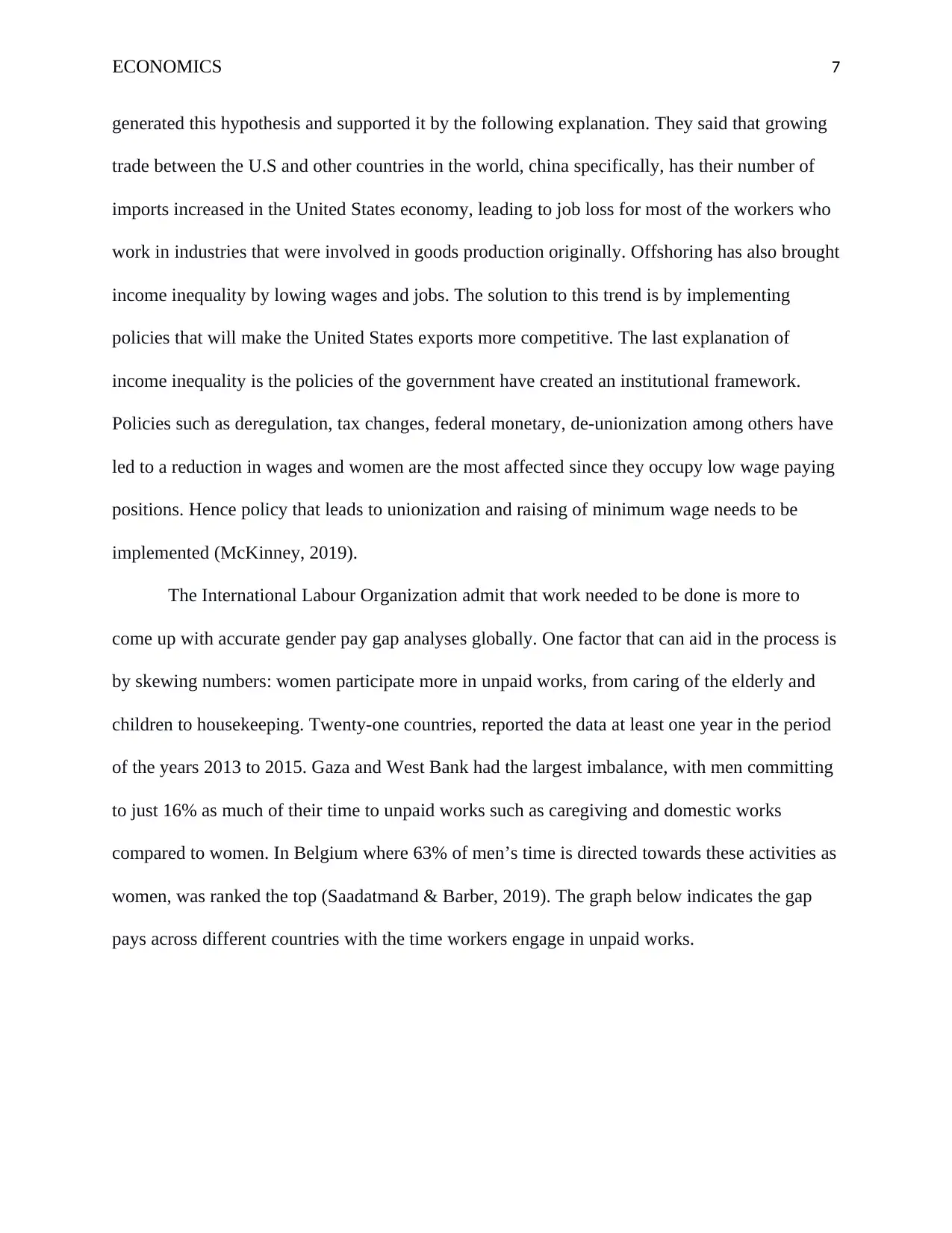
ECONOMICS 7
generated this hypothesis and supported it by the following explanation. They said that growing
trade between the U.S and other countries in the world, china specifically, has their number of
imports increased in the United States economy, leading to job loss for most of the workers who
work in industries that were involved in goods production originally. Offshoring has also brought
income inequality by lowing wages and jobs. The solution to this trend is by implementing
policies that will make the United States exports more competitive. The last explanation of
income inequality is the policies of the government have created an institutional framework.
Policies such as deregulation, tax changes, federal monetary, de-unionization among others have
led to a reduction in wages and women are the most affected since they occupy low wage paying
positions. Hence policy that leads to unionization and raising of minimum wage needs to be
implemented (McKinney, 2019).
The International Labour Organization admit that work needed to be done is more to
come up with accurate gender pay gap analyses globally. One factor that can aid in the process is
by skewing numbers: women participate more in unpaid works, from caring of the elderly and
children to housekeeping. Twenty-one countries, reported the data at least one year in the period
of the years 2013 to 2015. Gaza and West Bank had the largest imbalance, with men committing
to just 16% as much of their time to unpaid works such as caregiving and domestic works
compared to women. In Belgium where 63% of men’s time is directed towards these activities as
women, was ranked the top (Saadatmand & Barber, 2019). The graph below indicates the gap
pays across different countries with the time workers engage in unpaid works.
generated this hypothesis and supported it by the following explanation. They said that growing
trade between the U.S and other countries in the world, china specifically, has their number of
imports increased in the United States economy, leading to job loss for most of the workers who
work in industries that were involved in goods production originally. Offshoring has also brought
income inequality by lowing wages and jobs. The solution to this trend is by implementing
policies that will make the United States exports more competitive. The last explanation of
income inequality is the policies of the government have created an institutional framework.
Policies such as deregulation, tax changes, federal monetary, de-unionization among others have
led to a reduction in wages and women are the most affected since they occupy low wage paying
positions. Hence policy that leads to unionization and raising of minimum wage needs to be
implemented (McKinney, 2019).
The International Labour Organization admit that work needed to be done is more to
come up with accurate gender pay gap analyses globally. One factor that can aid in the process is
by skewing numbers: women participate more in unpaid works, from caring of the elderly and
children to housekeeping. Twenty-one countries, reported the data at least one year in the period
of the years 2013 to 2015. Gaza and West Bank had the largest imbalance, with men committing
to just 16% as much of their time to unpaid works such as caregiving and domestic works
compared to women. In Belgium where 63% of men’s time is directed towards these activities as
women, was ranked the top (Saadatmand & Barber, 2019). The graph below indicates the gap
pays across different countries with the time workers engage in unpaid works.
Paraphrase This Document
Need a fresh take? Get an instant paraphrase of this document with our AI Paraphraser
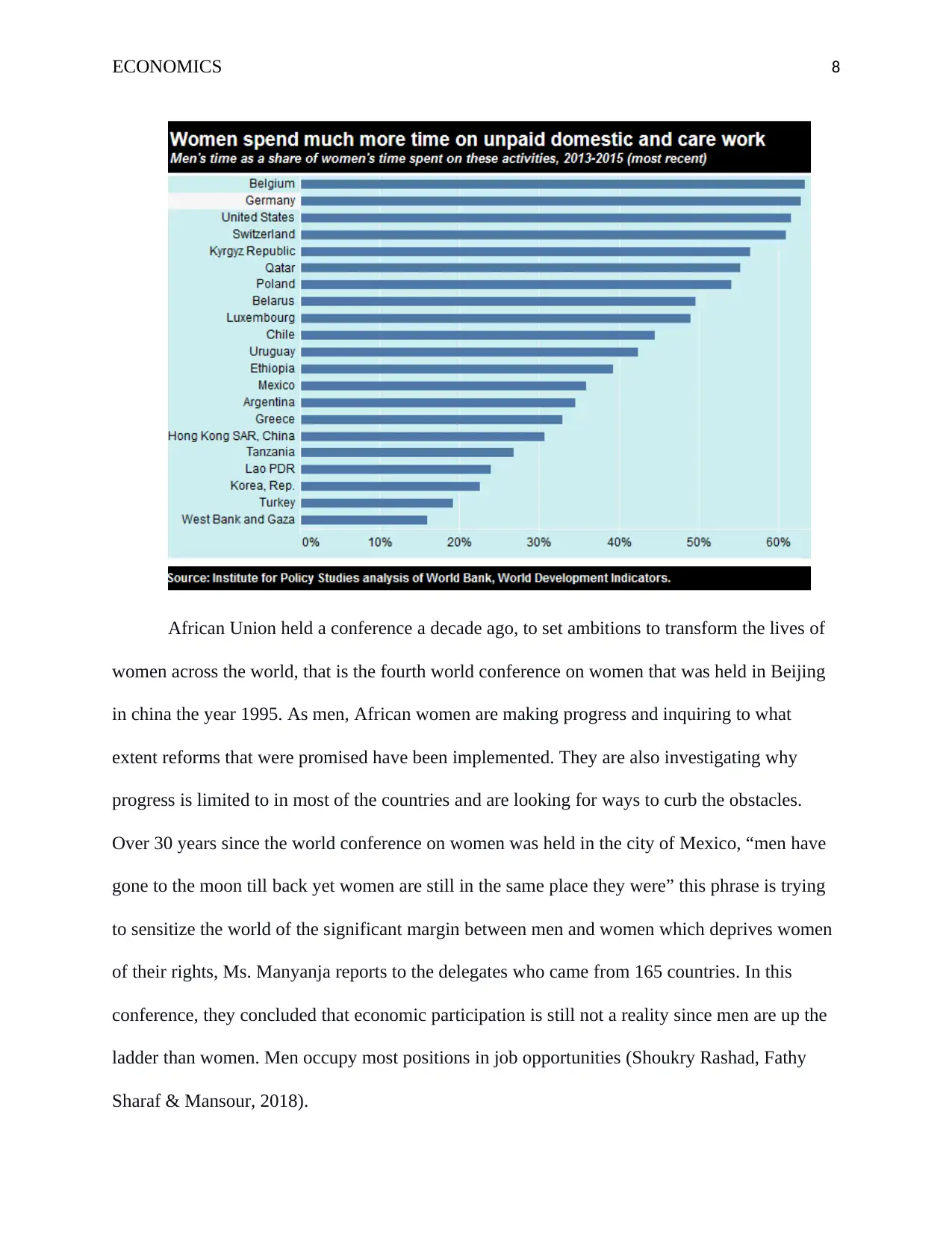
ECONOMICS 8
African Union held a conference a decade ago, to set ambitions to transform the lives of
women across the world, that is the fourth world conference on women that was held in Beijing
in china the year 1995. As men, African women are making progress and inquiring to what
extent reforms that were promised have been implemented. They are also investigating why
progress is limited to in most of the countries and are looking for ways to curb the obstacles.
Over 30 years since the world conference on women was held in the city of Mexico, “men have
gone to the moon till back yet women are still in the same place they were” this phrase is trying
to sensitize the world of the significant margin between men and women which deprives women
of their rights, Ms. Manyanja reports to the delegates who came from 165 countries. In this
conference, they concluded that economic participation is still not a reality since men are up the
ladder than women. Men occupy most positions in job opportunities (Shoukry Rashad, Fathy
Sharaf & Mansour, 2018).
African Union held a conference a decade ago, to set ambitions to transform the lives of
women across the world, that is the fourth world conference on women that was held in Beijing
in china the year 1995. As men, African women are making progress and inquiring to what
extent reforms that were promised have been implemented. They are also investigating why
progress is limited to in most of the countries and are looking for ways to curb the obstacles.
Over 30 years since the world conference on women was held in the city of Mexico, “men have
gone to the moon till back yet women are still in the same place they were” this phrase is trying
to sensitize the world of the significant margin between men and women which deprives women
of their rights, Ms. Manyanja reports to the delegates who came from 165 countries. In this
conference, they concluded that economic participation is still not a reality since men are up the
ladder than women. Men occupy most positions in job opportunities (Shoukry Rashad, Fathy
Sharaf & Mansour, 2018).
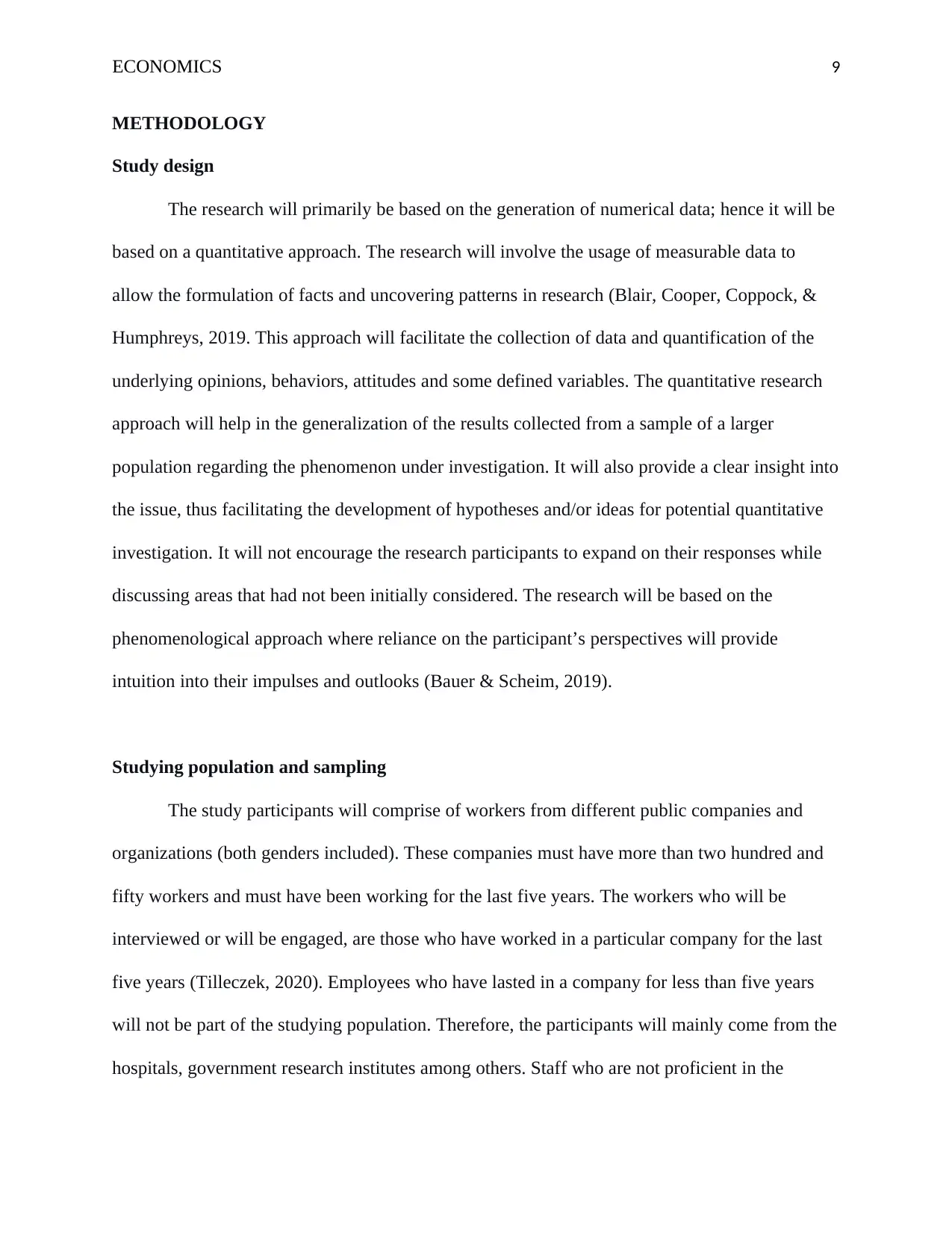
ECONOMICS 9
METHODOLOGY
Study design
The research will primarily be based on the generation of numerical data; hence it will be
based on a quantitative approach. The research will involve the usage of measurable data to
allow the formulation of facts and uncovering patterns in research (Blair, Cooper, Coppock, &
Humphreys, 2019. This approach will facilitate the collection of data and quantification of the
underlying opinions, behaviors, attitudes and some defined variables. The quantitative research
approach will help in the generalization of the results collected from a sample of a larger
population regarding the phenomenon under investigation. It will also provide a clear insight into
the issue, thus facilitating the development of hypotheses and/or ideas for potential quantitative
investigation. It will not encourage the research participants to expand on their responses while
discussing areas that had not been initially considered. The research will be based on the
phenomenological approach where reliance on the participant’s perspectives will provide
intuition into their impulses and outlooks (Bauer & Scheim, 2019).
Studying population and sampling
The study participants will comprise of workers from different public companies and
organizations (both genders included). These companies must have more than two hundred and
fifty workers and must have been working for the last five years. The workers who will be
interviewed or will be engaged, are those who have worked in a particular company for the last
five years (Tilleczek, 2020). Employees who have lasted in a company for less than five years
will not be part of the studying population. Therefore, the participants will mainly come from the
hospitals, government research institutes among others. Staff who are not proficient in the
METHODOLOGY
Study design
The research will primarily be based on the generation of numerical data; hence it will be
based on a quantitative approach. The research will involve the usage of measurable data to
allow the formulation of facts and uncovering patterns in research (Blair, Cooper, Coppock, &
Humphreys, 2019. This approach will facilitate the collection of data and quantification of the
underlying opinions, behaviors, attitudes and some defined variables. The quantitative research
approach will help in the generalization of the results collected from a sample of a larger
population regarding the phenomenon under investigation. It will also provide a clear insight into
the issue, thus facilitating the development of hypotheses and/or ideas for potential quantitative
investigation. It will not encourage the research participants to expand on their responses while
discussing areas that had not been initially considered. The research will be based on the
phenomenological approach where reliance on the participant’s perspectives will provide
intuition into their impulses and outlooks (Bauer & Scheim, 2019).
Studying population and sampling
The study participants will comprise of workers from different public companies and
organizations (both genders included). These companies must have more than two hundred and
fifty workers and must have been working for the last five years. The workers who will be
interviewed or will be engaged, are those who have worked in a particular company for the last
five years (Tilleczek, 2020). Employees who have lasted in a company for less than five years
will not be part of the studying population. Therefore, the participants will mainly come from the
hospitals, government research institutes among others. Staff who are not proficient in the
⊘ This is a preview!⊘
Do you want full access?
Subscribe today to unlock all pages.

Trusted by 1+ million students worldwide
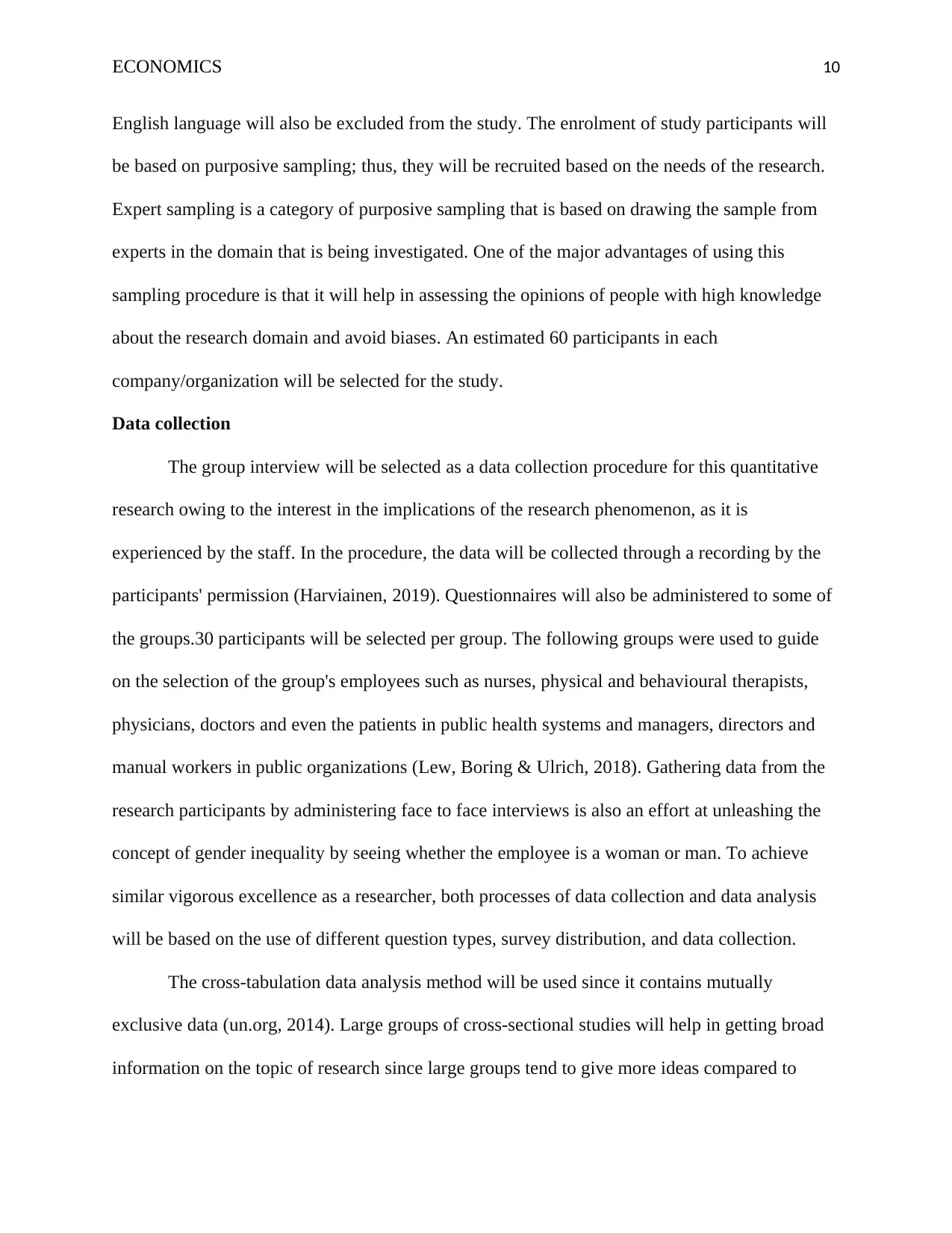
ECONOMICS 10
English language will also be excluded from the study. The enrolment of study participants will
be based on purposive sampling; thus, they will be recruited based on the needs of the research.
Expert sampling is a category of purposive sampling that is based on drawing the sample from
experts in the domain that is being investigated. One of the major advantages of using this
sampling procedure is that it will help in assessing the opinions of people with high knowledge
about the research domain and avoid biases. An estimated 60 participants in each
company/organization will be selected for the study.
Data collection
The group interview will be selected as a data collection procedure for this quantitative
research owing to the interest in the implications of the research phenomenon, as it is
experienced by the staff. In the procedure, the data will be collected through a recording by the
participants' permission (Harviainen, 2019). Questionnaires will also be administered to some of
the groups.30 participants will be selected per group. The following groups were used to guide
on the selection of the group's employees such as nurses, physical and behavioural therapists,
physicians, doctors and even the patients in public health systems and managers, directors and
manual workers in public organizations (Lew, Boring & Ulrich, 2018). Gathering data from the
research participants by administering face to face interviews is also an effort at unleashing the
concept of gender inequality by seeing whether the employee is a woman or man. To achieve
similar vigorous excellence as a researcher, both processes of data collection and data analysis
will be based on the use of different question types, survey distribution, and data collection.
The cross-tabulation data analysis method will be used since it contains mutually
exclusive data (un.org, 2014). Large groups of cross-sectional studies will help in getting broad
information on the topic of research since large groups tend to give more ideas compared to
English language will also be excluded from the study. The enrolment of study participants will
be based on purposive sampling; thus, they will be recruited based on the needs of the research.
Expert sampling is a category of purposive sampling that is based on drawing the sample from
experts in the domain that is being investigated. One of the major advantages of using this
sampling procedure is that it will help in assessing the opinions of people with high knowledge
about the research domain and avoid biases. An estimated 60 participants in each
company/organization will be selected for the study.
Data collection
The group interview will be selected as a data collection procedure for this quantitative
research owing to the interest in the implications of the research phenomenon, as it is
experienced by the staff. In the procedure, the data will be collected through a recording by the
participants' permission (Harviainen, 2019). Questionnaires will also be administered to some of
the groups.30 participants will be selected per group. The following groups were used to guide
on the selection of the group's employees such as nurses, physical and behavioural therapists,
physicians, doctors and even the patients in public health systems and managers, directors and
manual workers in public organizations (Lew, Boring & Ulrich, 2018). Gathering data from the
research participants by administering face to face interviews is also an effort at unleashing the
concept of gender inequality by seeing whether the employee is a woman or man. To achieve
similar vigorous excellence as a researcher, both processes of data collection and data analysis
will be based on the use of different question types, survey distribution, and data collection.
The cross-tabulation data analysis method will be used since it contains mutually
exclusive data (un.org, 2014). Large groups of cross-sectional studies will help in getting broad
information on the topic of research since large groups tend to give more ideas compared to
Paraphrase This Document
Need a fresh take? Get an instant paraphrase of this document with our AI Paraphraser
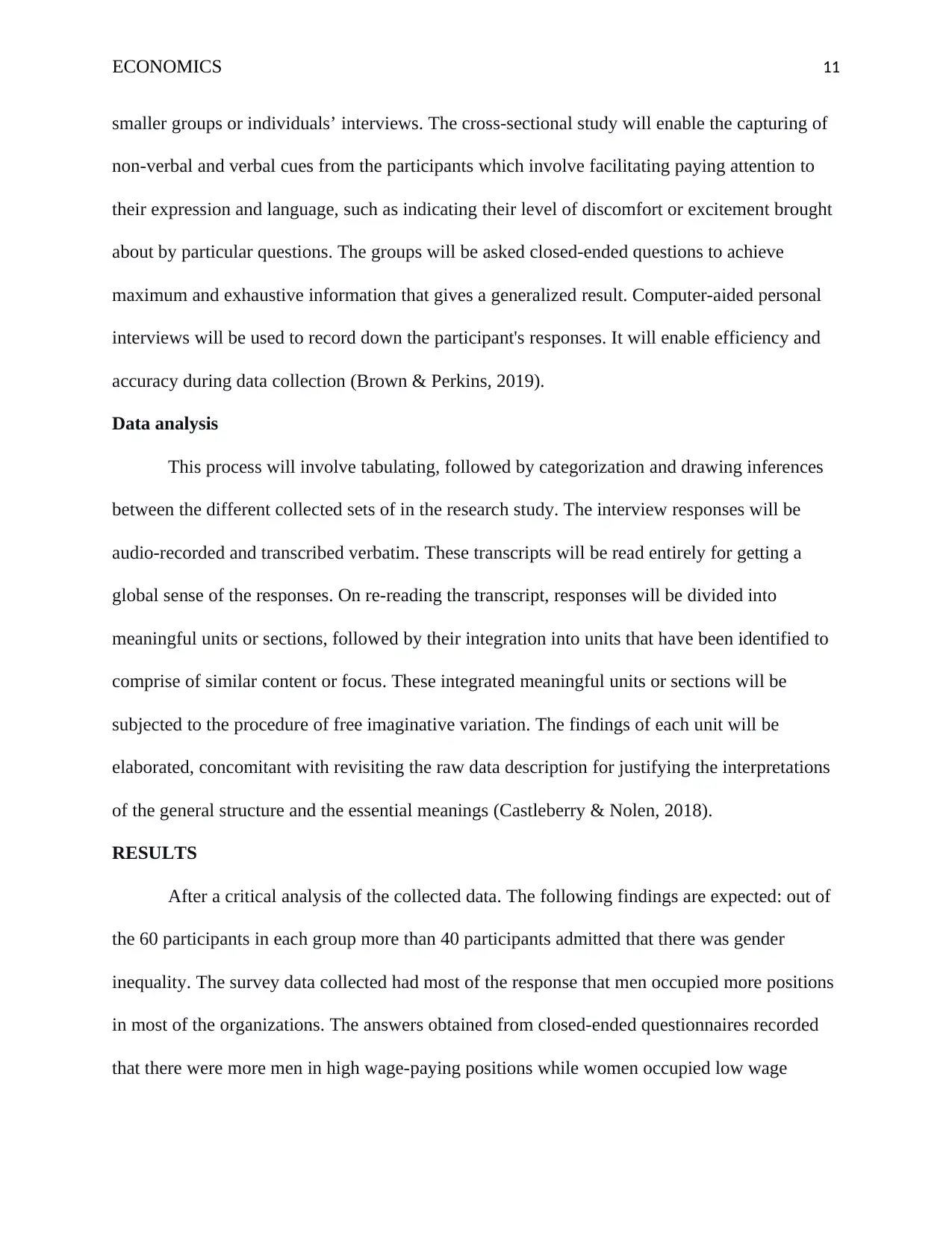
ECONOMICS 11
smaller groups or individuals’ interviews. The cross-sectional study will enable the capturing of
non-verbal and verbal cues from the participants which involve facilitating paying attention to
their expression and language, such as indicating their level of discomfort or excitement brought
about by particular questions. The groups will be asked closed-ended questions to achieve
maximum and exhaustive information that gives a generalized result. Computer-aided personal
interviews will be used to record down the participant's responses. It will enable efficiency and
accuracy during data collection (Brown & Perkins, 2019).
Data analysis
This process will involve tabulating, followed by categorization and drawing inferences
between the different collected sets of in the research study. The interview responses will be
audio-recorded and transcribed verbatim. These transcripts will be read entirely for getting a
global sense of the responses. On re-reading the transcript, responses will be divided into
meaningful units or sections, followed by their integration into units that have been identified to
comprise of similar content or focus. These integrated meaningful units or sections will be
subjected to the procedure of free imaginative variation. The findings of each unit will be
elaborated, concomitant with revisiting the raw data description for justifying the interpretations
of the general structure and the essential meanings (Castleberry & Nolen, 2018).
RESULTS
After a critical analysis of the collected data. The following findings are expected: out of
the 60 participants in each group more than 40 participants admitted that there was gender
inequality. The survey data collected had most of the response that men occupied more positions
in most of the organizations. The answers obtained from closed-ended questionnaires recorded
that there were more men in high wage-paying positions while women occupied low wage
smaller groups or individuals’ interviews. The cross-sectional study will enable the capturing of
non-verbal and verbal cues from the participants which involve facilitating paying attention to
their expression and language, such as indicating their level of discomfort or excitement brought
about by particular questions. The groups will be asked closed-ended questions to achieve
maximum and exhaustive information that gives a generalized result. Computer-aided personal
interviews will be used to record down the participant's responses. It will enable efficiency and
accuracy during data collection (Brown & Perkins, 2019).
Data analysis
This process will involve tabulating, followed by categorization and drawing inferences
between the different collected sets of in the research study. The interview responses will be
audio-recorded and transcribed verbatim. These transcripts will be read entirely for getting a
global sense of the responses. On re-reading the transcript, responses will be divided into
meaningful units or sections, followed by their integration into units that have been identified to
comprise of similar content or focus. These integrated meaningful units or sections will be
subjected to the procedure of free imaginative variation. The findings of each unit will be
elaborated, concomitant with revisiting the raw data description for justifying the interpretations
of the general structure and the essential meanings (Castleberry & Nolen, 2018).
RESULTS
After a critical analysis of the collected data. The following findings are expected: out of
the 60 participants in each group more than 40 participants admitted that there was gender
inequality. The survey data collected had most of the response that men occupied more positions
in most of the organizations. The answers obtained from closed-ended questionnaires recorded
that there were more men in high wage-paying positions while women occupied low wage
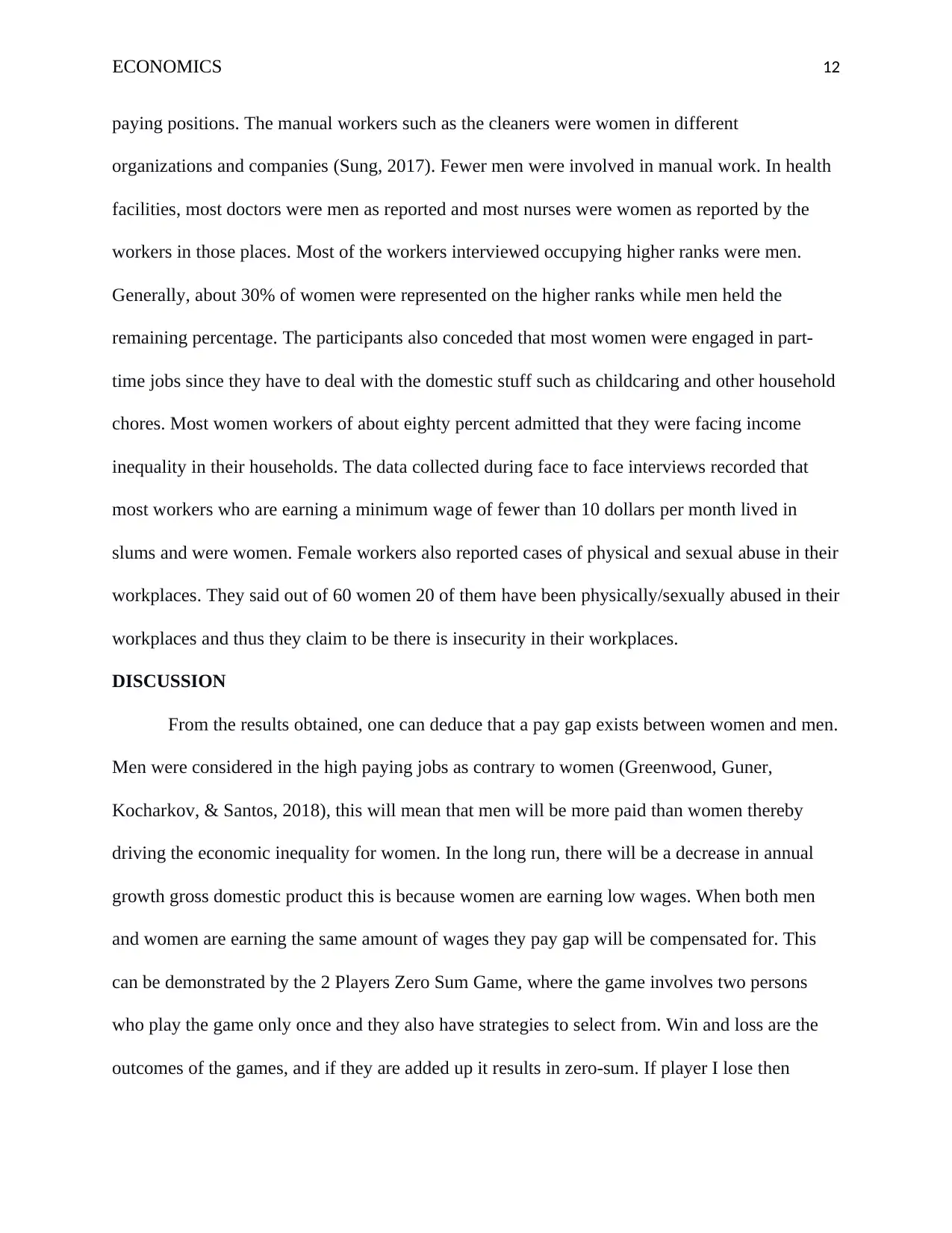
ECONOMICS 12
paying positions. The manual workers such as the cleaners were women in different
organizations and companies (Sung, 2017). Fewer men were involved in manual work. In health
facilities, most doctors were men as reported and most nurses were women as reported by the
workers in those places. Most of the workers interviewed occupying higher ranks were men.
Generally, about 30% of women were represented on the higher ranks while men held the
remaining percentage. The participants also conceded that most women were engaged in part-
time jobs since they have to deal with the domestic stuff such as childcaring and other household
chores. Most women workers of about eighty percent admitted that they were facing income
inequality in their households. The data collected during face to face interviews recorded that
most workers who are earning a minimum wage of fewer than 10 dollars per month lived in
slums and were women. Female workers also reported cases of physical and sexual abuse in their
workplaces. They said out of 60 women 20 of them have been physically/sexually abused in their
workplaces and thus they claim to be there is insecurity in their workplaces.
DISCUSSION
From the results obtained, one can deduce that a pay gap exists between women and men.
Men were considered in the high paying jobs as contrary to women (Greenwood, Guner,
Kocharkov, & Santos, 2018), this will mean that men will be more paid than women thereby
driving the economic inequality for women. In the long run, there will be a decrease in annual
growth gross domestic product this is because women are earning low wages. When both men
and women are earning the same amount of wages they pay gap will be compensated for. This
can be demonstrated by the 2 Players Zero Sum Game, where the game involves two persons
who play the game only once and they also have strategies to select from. Win and loss are the
outcomes of the games, and if they are added up it results in zero-sum. If player I lose then
paying positions. The manual workers such as the cleaners were women in different
organizations and companies (Sung, 2017). Fewer men were involved in manual work. In health
facilities, most doctors were men as reported and most nurses were women as reported by the
workers in those places. Most of the workers interviewed occupying higher ranks were men.
Generally, about 30% of women were represented on the higher ranks while men held the
remaining percentage. The participants also conceded that most women were engaged in part-
time jobs since they have to deal with the domestic stuff such as childcaring and other household
chores. Most women workers of about eighty percent admitted that they were facing income
inequality in their households. The data collected during face to face interviews recorded that
most workers who are earning a minimum wage of fewer than 10 dollars per month lived in
slums and were women. Female workers also reported cases of physical and sexual abuse in their
workplaces. They said out of 60 women 20 of them have been physically/sexually abused in their
workplaces and thus they claim to be there is insecurity in their workplaces.
DISCUSSION
From the results obtained, one can deduce that a pay gap exists between women and men.
Men were considered in the high paying jobs as contrary to women (Greenwood, Guner,
Kocharkov, & Santos, 2018), this will mean that men will be more paid than women thereby
driving the economic inequality for women. In the long run, there will be a decrease in annual
growth gross domestic product this is because women are earning low wages. When both men
and women are earning the same amount of wages they pay gap will be compensated for. This
can be demonstrated by the 2 Players Zero Sum Game, where the game involves two persons
who play the game only once and they also have strategies to select from. Win and loss are the
outcomes of the games, and if they are added up it results in zero-sum. If player I lose then
⊘ This is a preview!⊘
Do you want full access?
Subscribe today to unlock all pages.

Trusted by 1+ million students worldwide
1 out of 17
Related Documents
Your All-in-One AI-Powered Toolkit for Academic Success.
+13062052269
info@desklib.com
Available 24*7 on WhatsApp / Email
![[object Object]](/_next/static/media/star-bottom.7253800d.svg)
Unlock your academic potential
Copyright © 2020–2025 A2Z Services. All Rights Reserved. Developed and managed by ZUCOL.





